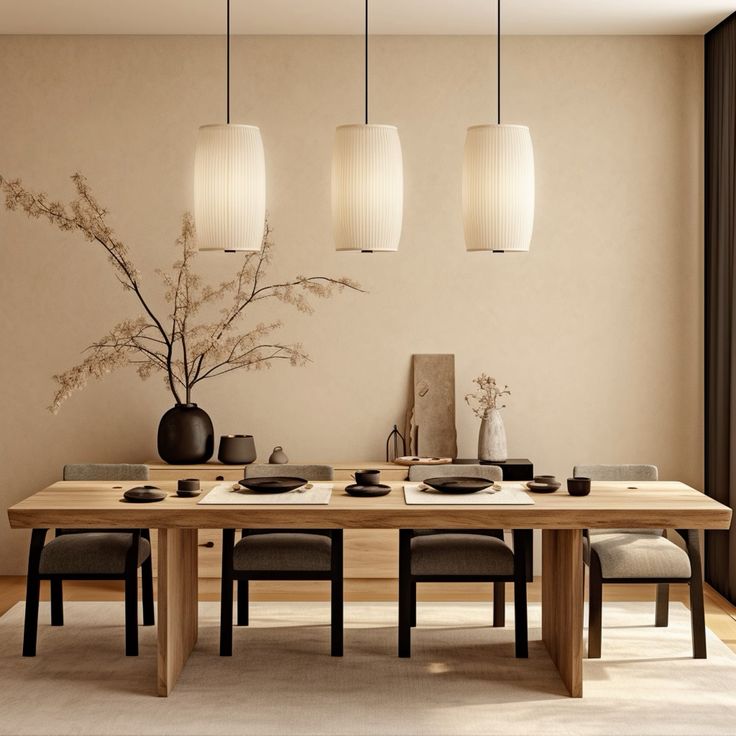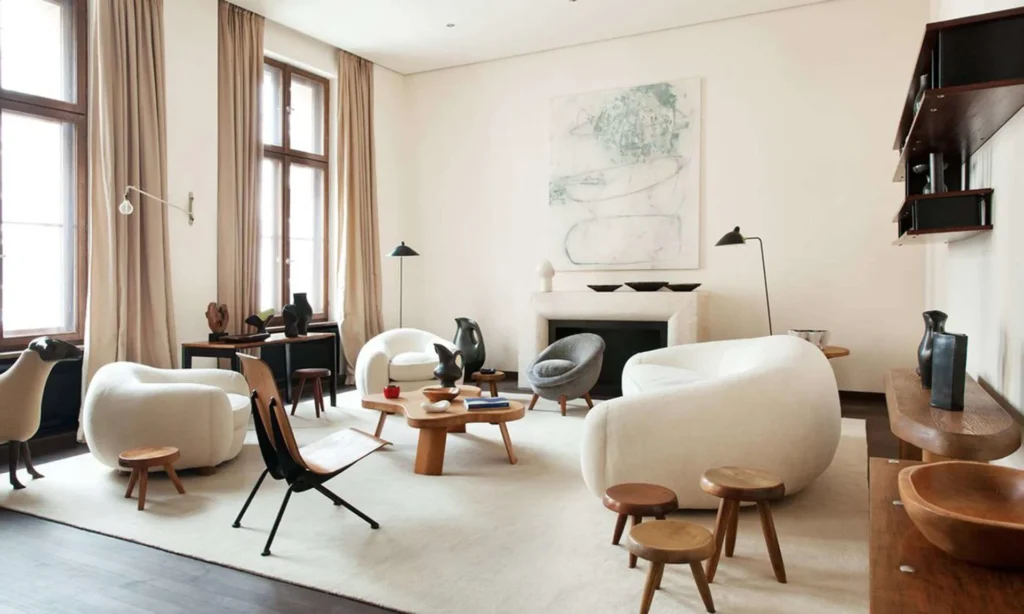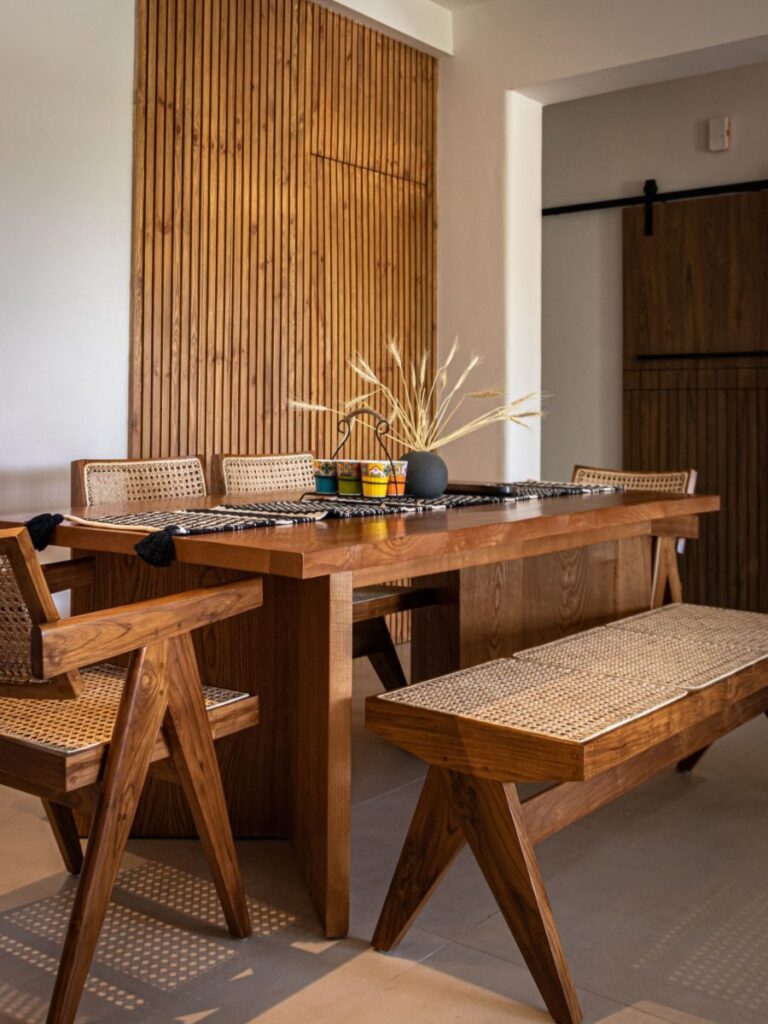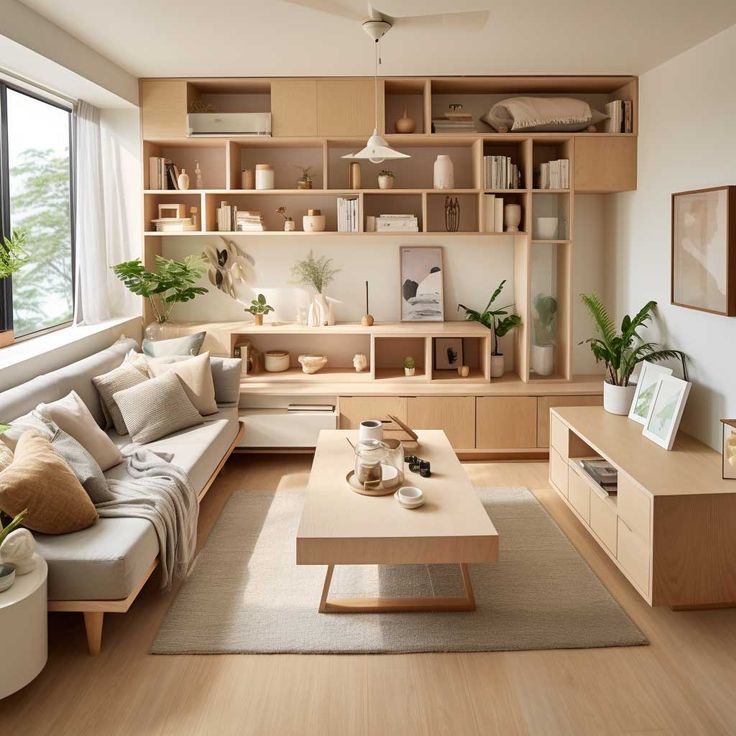What We'll Cover
ToggleOrigins of Japanese Minimalism
Japanese design has a rich history deeply rooted in the principles of minimalism, functionality, and harmony with nature. Influenced by Zen Buddhism and traditional Japanese aesthetics such as wabi-sabi (finding beauty in imperfection) and kanso (simplicity), Japanese interiors have long been characterized by clean lines, uncluttered spaces, and a focus on craftsmanship and natural materials.

Dating back centuries, traditional Japanese architecture and interior design have emphasized the use of sliding doors (shoji), tatami mats, and sliding screens (fusuma) to create flexible, multi-functional spaces that blur the boundaries between indoors and outdoors. These design elements prioritize simplicity, versatility, and a deep connection to the surrounding environment.
Rise of Scandinavian Design:

In contrast, Scandinavian design emerged in the mid-20th century as a response to the social and economic changes sweeping through Northern Europe. Influenced by the tenets of modernism and the harsh climate of the Nordic region, Scandinavian design prioritized functionality, comfort, and egalitarianism.
Pioneered by iconic designers such as Arne Jacobsen, Alvar Aalto, and Hans Wegner, Scandinavian interiors are characterized by their clean lines, organic forms, and emphasis on light, natural materials such as wood, leather, and wool. Scandinavian design also embraces the concept of hygge, a Danish word that conveys a feeling of coziness, warmth, and contentment.
The Emergence of Japandi Style:

The convergence of Japanese minimalism and Scandinavian coziness into what we now know as Japandi style can be traced back to the early 21st century. As globalization facilitated greater cultural exchange and appreciation for diverse design aesthetics, designers and homeowners alike began to seek out a harmonious fusion of Eastern and Western influences.
Japandi style represents a natural marriage of the timeless elegance and simplicity of Japanese design with the warmth, comfort, and craftsmanship of Scandinavian interiors. It embodies a sense of balance, tranquility, and understated luxury, creating spaces that feel both inviting and uncluttered.
Contemporary Influence and Global Appeal:

In recent years, Japandi style has gained momentum as a prominent interior design trend, capturing the hearts and homes of design enthusiasts around the world. Its universal appeal lies in its ability to create spaces that transcend cultural boundaries, offering a sanctuary of simplicity and serenity in an increasingly chaotic world.
From minimalist apartments in Tokyo to cozy cottages in Copenhagen and contemporary homes in cities worldwide, Japandi style continues to evolve and inspire, proving that the fusion of different design traditions can result in something truly timeless and transcendent. As we look to the future, Japandi style serves as a reminder of the power of design to unite, uplift, and enrich our lives.
A Closer Look: Japandi vs. Scandinavian
At first glance, Japandi and Scandinavian design may appear strikingly similar, both embodying the principles of minimalism, functionality, and a deep reverence for nature. Their clean lines, muted color palettes, and emphasis on simplicity create an aesthetic harmony that resonates with enthusiasts of modern interior design. However, upon closer examination, subtle nuances emerge, allowing us to distinguish between these two distinct design philosophies. By dissecting their aesthetics, color palettes, materials, furniture choices, and accessories, we can unravel the unique essence of each style and appreciate the artful fusion or delightful contrasts they offer to spaces.
Now, let’s delve into a detailed comparison between Japandi and Scandinavian design across various aspects:
Aesthetics – Japandi Interior Design vs Scandinavian Interior Design
Japandi: Strikes a balance between the minimalism of Scandinavian design and the warmth of Japanese aesthetics. Focuses on clean lines, uncluttered spaces, and a sense of tranquility.
Scandinavian: Emphasizes simplicity, functionality, and light-filled spaces. Features clean, minimalist aesthetics with a cozy, inviting atmosphere.
Color Palette – Japandi Interior Design vs Scandinavian Interior Design
Japandi: Incorporates a neutral color palette with earthy tones such as beige, gray, and brown. Accents of muted colors inspired by nature may also be introduced.
Scandinavian: Predominantly uses white as a base color to enhance brightness and openness. Accents of soft pastels and pops of color inspired by nature are common.
Materials – Japandi Interior Design vs Scandinavian Interior Design
Japandi: Utilizes natural materials like wood, bamboo, stone, and paper to create a sense of warmth and connection to nature. Textural elements such as rattan and linen may also be incorporated.
Scandinavian: Embraces light woods such as pine, birch, and beech, alongside other natural materials like leather, wool, and metal. Focuses on creating a harmonious blend of functionality and aesthetics.
Furniture – Japandi Interior Design vs Scandinavian Interior Design
Japandi: Features minimalist furniture with clean lines and functional design. Emphasizes craftsmanship and quality, with pieces that exude simplicity and elegance.
Scandinavian: Showcases iconic designs characterized by simplicity, functionality, and comfort. Furniture often combines organic shapes with sleek lines, offering both visual appeal and practicality.
Accessories – Japandi Interior Design vs Scandinavian Interior Design
Japandi: Prefers a curated selection of accessories with a focus on functionality and aesthetics. Incorporates natural elements such as ceramics, pottery, and woven textiles for added warmth.
Scandinavian: Highlights functional accessories that add warmth and personality to spaces. Incorporates elements like textiles, cushions, rugs, and artwork to create a cozy, inviting ambiance.
To sum up this comparison, while Japandi and Scandinavian design share similarities in their minimalist ethos and connection to nature, they each possess distinctive characteristics that set them apart. Japandi design blends Japanese elegance with Scandinavian functionality, resulting in spaces that are serene, harmonious, and timeless. On the other hand, Scandinavian design prioritizes simplicity, light-filled interiors, and cozy atmospheres, creating spaces that exude warmth and comfort. Whether you’re drawn to the tranquility of Japandi or the cozy charm of Scandinavian design, both styles offer endless inspiration for creating inviting and stylish interiors.
Japandi Resurgence in India

In the dynamic landscape of interior design in India, a new wave of aesthetic appreciation is emerging with the resurgence of Japandi design. Drawing inspiration from the minimalist elegance of Scandinavian interiors and the timeless sophistication of Japanese aesthetics, Japandi design offers a refreshing blend of cultures, styles, and principles. As urbanization accelerates and sustainability consciousness grows, Indian homeowners are increasingly drawn to the clean lines, tranquil spaces, and natural elements characteristic of Japandi design. This fusion of global influences with local sensibilities reflects a shifting paradigm in Indian interior design, where functionality, sustainability, and cultural appreciation converge to create spaces that are both aesthetically pleasing and mindful of contemporary living needs. In this exploration, we delve into the resurgence of Japandi design in India, uncovering its influences, appeal, and implications for the evolving design ethos in the country.
Global Influence of Japandi Interior Design
With the rise of social media and online platforms showcasing interior design trends from around the world, Indian homeowners are increasingly exposed to international design styles, including Japandi. The allure of Japandi’s minimalist elegance and tranquil aesthetic resonates with individuals seeking to create modern, sophisticated interiors.
Urbanization and Lifestyle Changes
As urbanization continues to accelerate in India, especially in metropolitan cities like Mumbai, Delhi, and Bangalore, there’s a growing demand for contemporary, space-efficient interior design solutions. Japandi design’s emphasis on clean lines, uncluttered spaces, and functionality makes it particularly appealing to urban dwellers looking to optimize their living spaces.
Sustainability Consciousness
India is witnessing a shift towards sustainable living practices, driven by environmental concerns and a growing awareness of eco-friendly alternatives. Japandi design’s focus on natural materials, artisanal craftsmanship, and timeless aesthetics aligns with this sustainability ethos, attracting environmentally conscious homeowners seeking to reduce their carbon footprint.
Cultural Appreciation
Indian culture has a deep appreciation for craftsmanship, tradition, and natural elements. Japandi design’s fusion of Japanese and Scandinavian aesthetics resonates with Indian sensibilities, offering a contemporary interpretation of traditional design principles. Elements such as wood, bamboo, and handcrafted textiles complement India’s rich heritage and cultural ethos.
Adaptability to Indian Homes
Japandi design’s versatility and adaptability make it well-suited for Indian homes, ranging from compact apartments to spacious villas. Its minimalist aesthetic allows for easy integration with existing decor styles, while its emphasis on functionality addresses the practical needs of Indian households.
Design Evolution
Indian interior designers and architects are increasingly incorporating global design influences into their projects, resulting in a more eclectic and cosmopolitan design landscape. Japandi design’s resurgence reflects this evolving design ethos, offering a contemporary yet timeless aesthetic that appeals to a wide range of homeowners across India.
In a Nutshell
In conclusion, the resurgence of Japandi design in India reflects a dynamic shift in the country’s interior design landscape, driven by factors such as global influence, urbanization, sustainability consciousness, cultural appreciation, and adaptability to modern living. As Indian homeowners seek sophisticated yet functional spaces that reflect their evolving lifestyles and values, Japandi design offers a compelling fusion of Japanese minimalism and Scandinavian coziness. Its emphasis on clean lines, natural materials, and timeless aesthetics resonates with individuals looking to create tranquil, harmonious interiors that are both stylish and mindful of contemporary living needs.
Furthermore, the adaptability of Japandi design to diverse home settings, from compact urban apartments to spacious suburban homes, ensures its relevance across various lifestyles and preferences. As Indian interior designers continue to embrace global influences while infusing them with local sensibilities, Japandi design serves as a catalyst for innovation and creativity in the quest for modern, sustainable living spaces.
Overall, the resurgence of Japandi design in India signifies more than just a passing trend—it embodies a deeper cultural shift towards design that is both aesthetically pleasing and mindful of environmental impact. By blending the best of Eastern and Western design traditions, Japandi design offers a timeless, elegant aesthetic that speaks to the aspirations and values of contemporary Indian homeowners, enriching their living experiences in the process.
FAQs
Japandi design is a fusion of Japanese minimalism and Scandinavian coziness. It blends clean lines, uncluttered spaces, and a sense of tranquility from Japanese aesthetics with the warmth, comfort, and craftsmanship of Scandinavian interiors. While traditional Japanese design often emphasizes simplicity and connection with nature, and Scandinavian design prioritizes functionality and light-filled spaces, Japandi finds a harmonious balance between these elements.
Japandi design has gained popularity in India due to its modern yet timeless appeal, adaptability to diverse living spaces, emphasis on sustainability, and alignment with Indian sensibilities regarding craftsmanship and natural elements. Additionally, as urbanization accelerates in India, homeowners seek efficient and stylish interior design solutions, making Japandi’s minimalist ethos particularly attractive.
Homeowners can incorporate Japandi design elements by focusing on clean lines, neutral color palettes, natural materials, and functional furniture pieces. Adding touches of warmth through textiles and accessories inspired by nature can enhance the cozy atmosphere characteristic of Japandi interiors.
Japandi design typically incorporates neutral color palettes with earthy tones such as beige, gray, and brown, along with accents of muted colors inspired by nature. These color schemes can be adapted to Indian homes by complementing them with traditional Indian textiles or artwork, adding depth and character to the space.
Essential furniture pieces for Japandi design include minimalist seating options, such as low-profile sofas or lounge chairs, along with natural wood tables and storage solutions with clean lines. Decor items such as ceramics, pottery, and woven textiles can add texture and warmth to the space.
Yes, Japandi design can be applied to various living spaces, including apartments, houses, and offices. Its minimalist aesthetic and focus on functionality make it versatile and adaptable to different environments, regardless of size or layout.
Japandi design emphasizes the use of natural materials, artisanal craftsmanship, and timeless aesthetics, which align with sustainability and eco-friendly living practices. By opting for durable, high-quality furniture and decor items made from renewable resources, homeowners can reduce their environmental impact while creating stylish and sustainable interiors.
While Japandi design draws inspiration from Japanese and Scandinavian aesthetics, it’s essential to respect and integrate elements of Indian culture and heritage into the design. This could involve incorporating traditional Indian textiles, artwork, or craftsmanship techniques to create a harmonious fusion of global and local influences.
To balance minimalism with warmth in Japandi design, homeowners can layer soft textiles such as rugs, cushions, and throws to add texture and coziness to the space. Additionally, incorporating warm lighting fixtures and natural elements like indoor plants can create a welcoming atmosphere while maintaining the clean, uncluttered look of Japandi interiors.
Several Indian designers and architects have embraced Japandi design principles in their projects, demonstrating its versatility and relevance in the Indian context. By studying their work, we can learn how to adapt Japandi aesthetics to suit Indian lifestyles, preferences, and cultural sensibilities, thereby creating spaces that are both globally inspired and locally rooted.





